12.5 Imagining
Poets and artists have an ability to create imaginary and alternative worlds. Consider what each artist and poet is trying to convey in the following texts. Which images and poems do you find most interesting?
Consider the following questions:
-How would you describe imagination?
-How important is imagination to the creative process?
-How do the art images and poems enrich our understanding of ourselves and the world?
-Can you create a visual image of one of the poems featured in this section?
-Why does a particular art image and poem make sense to you?
-How does this work make you think or feel differently?
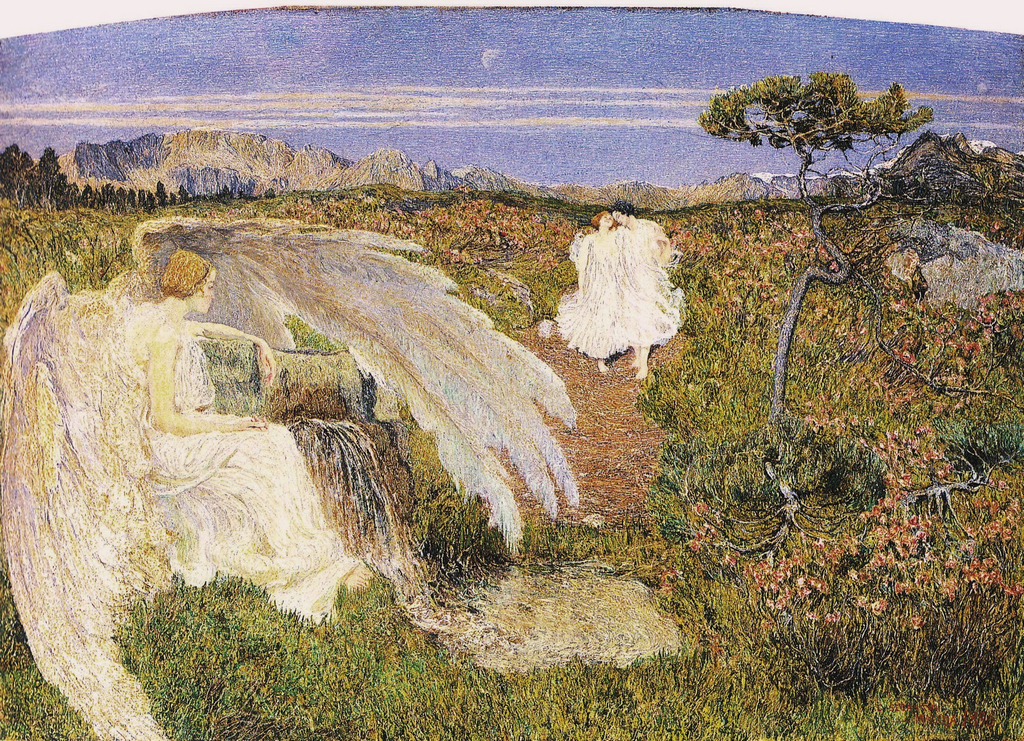
“Dream Land” by Christina Rossetti
For more poems by Christina Rossetti, please open the Project Gutenberg link here.
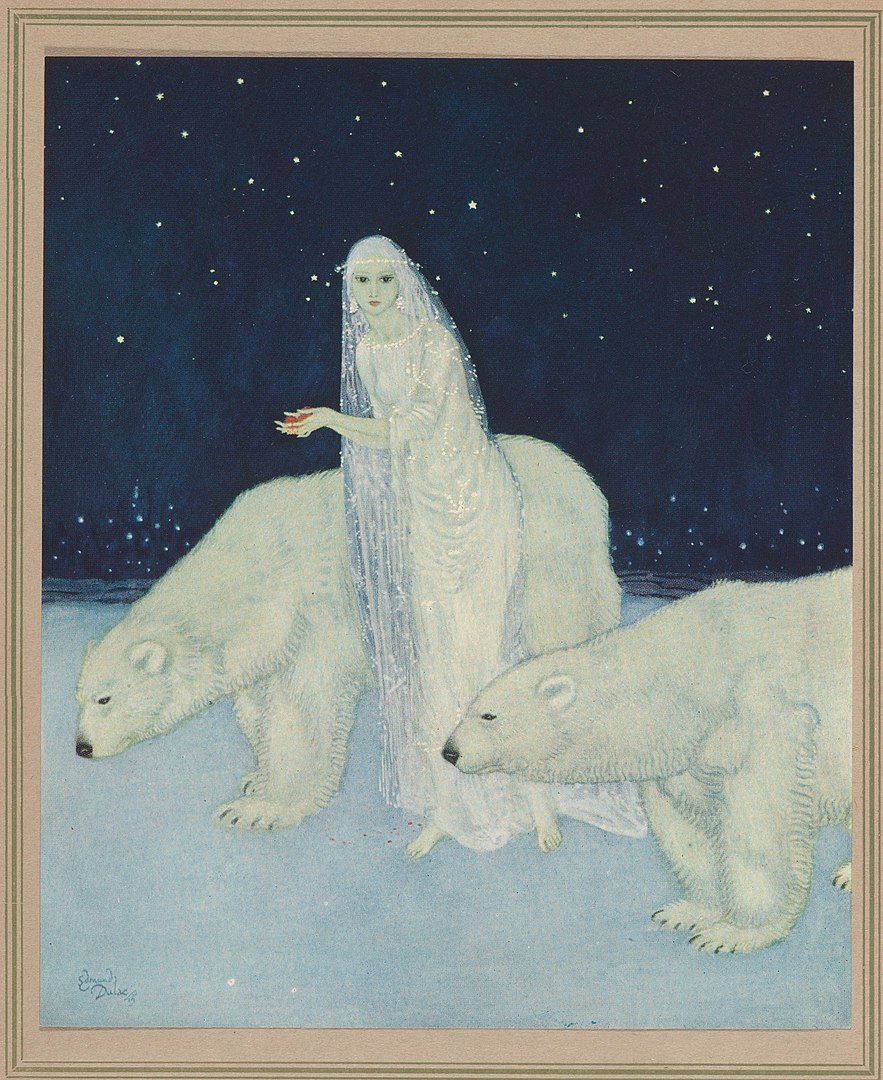
“Everything about her was white, glistening and white.” -For more details about the story behind the art, please open the link here.
“Dreams” by Walter de la Mare
Be gentle, O hands of a child;
Be true: like a shadowy sea
In the starry darkness of night
Are your eyes to me.
But words are shallow, and soon
Dreams fade that the heart once knew;
And youth fades out in the mind,
In the dark eyes too.
What can a tired heart say,
Which the wise of the world made dumb?
Save to the lonely dreams of a child;
‘Return again, come’! Dreams.
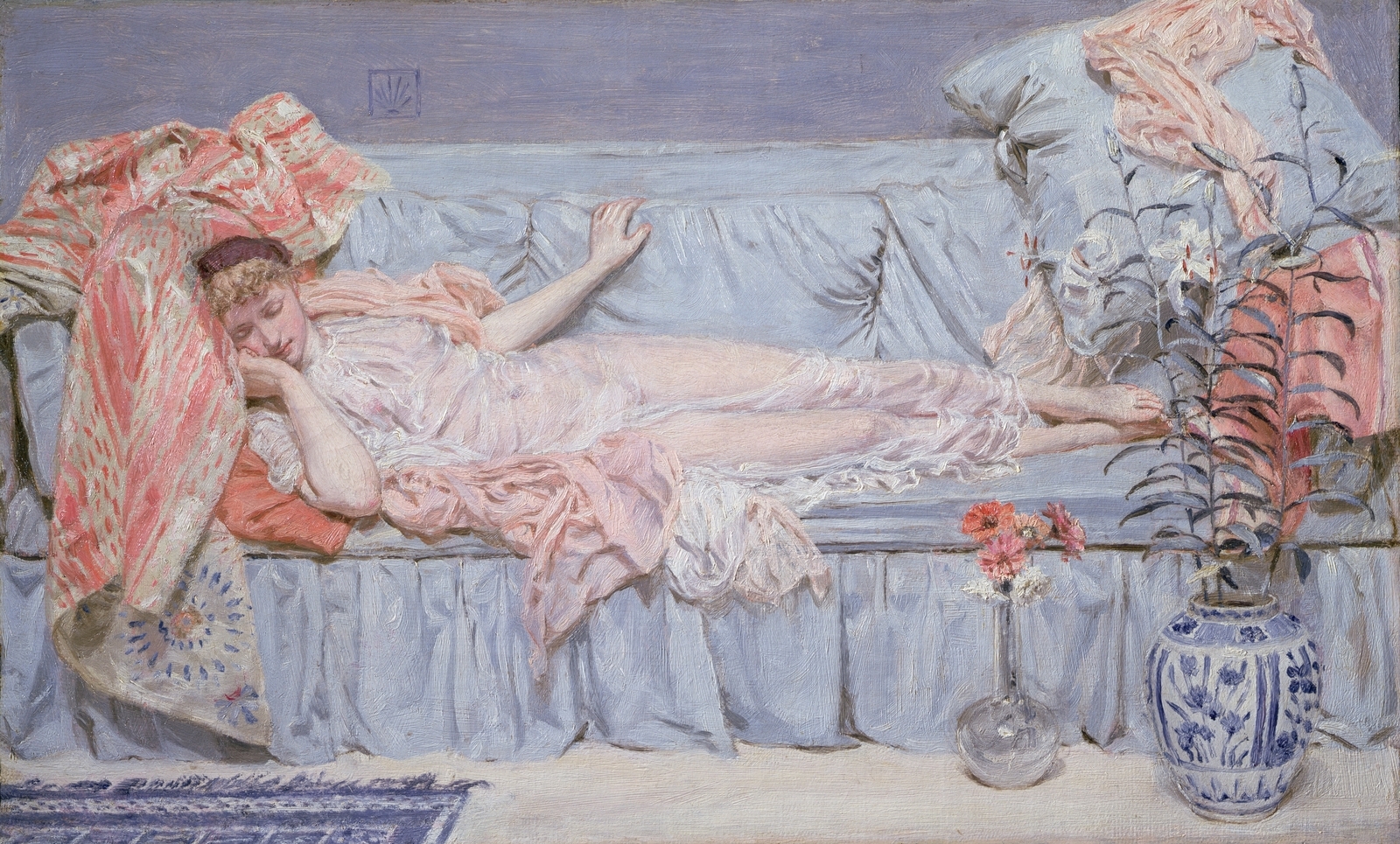
Clark Institute of Art Note about Lilies by Albert Joseph Moore:
“Drawn to the philosophy of making “art for art’s sake”, Moore emphasized the formal elements of this painting, its color and design, over narrative subject matter. The painting’s title, Lilies, redirects our attention from the reclining figure to the painting’s decorative details—the lilies growing from the blue-and-white vase, the rug on the floor, the subtle folds and textures of the various fabrics, and the way these details combine to make a balanced composition.” Retrieved June 12 2023.
Note about the Painting,-National Museum of Sweden, Stockholm, Sweden
“The moon illuminates a still landscape through which a river flows sedately. Trees appear as dark silhouettes against the sky. Hand-in-hand, the elves sweep like a wispy mist through the landscape, their movements like a ring dance. One elf kisses the surface of the water or is reflected in it. Like the others, she has long flowing hair and is wearing a garland. As a contemporary critic pointed out, you can either see the morning mist over the landscape as dancing elves, or you can see the dancing elves as a morning mist. If you choose to focus in on the morning mist, the elves can be explained as the movement of the mist. The painting can then be described as a romantic landscape, where nature is imbued with a spirit of its own. If instead, you see the dancing elves as the key motif, the painting can be described as a depiction of the fairytale world. According to Swedish folk lore, elves live in nature and are often seen dancing around hills, burial mounds, mountains and forests. People were warned to watch out for elves, as they made people ill. August Malmström’s Älvalek became a widely recognised image through versions and reproductions in magazines and illustrations.”
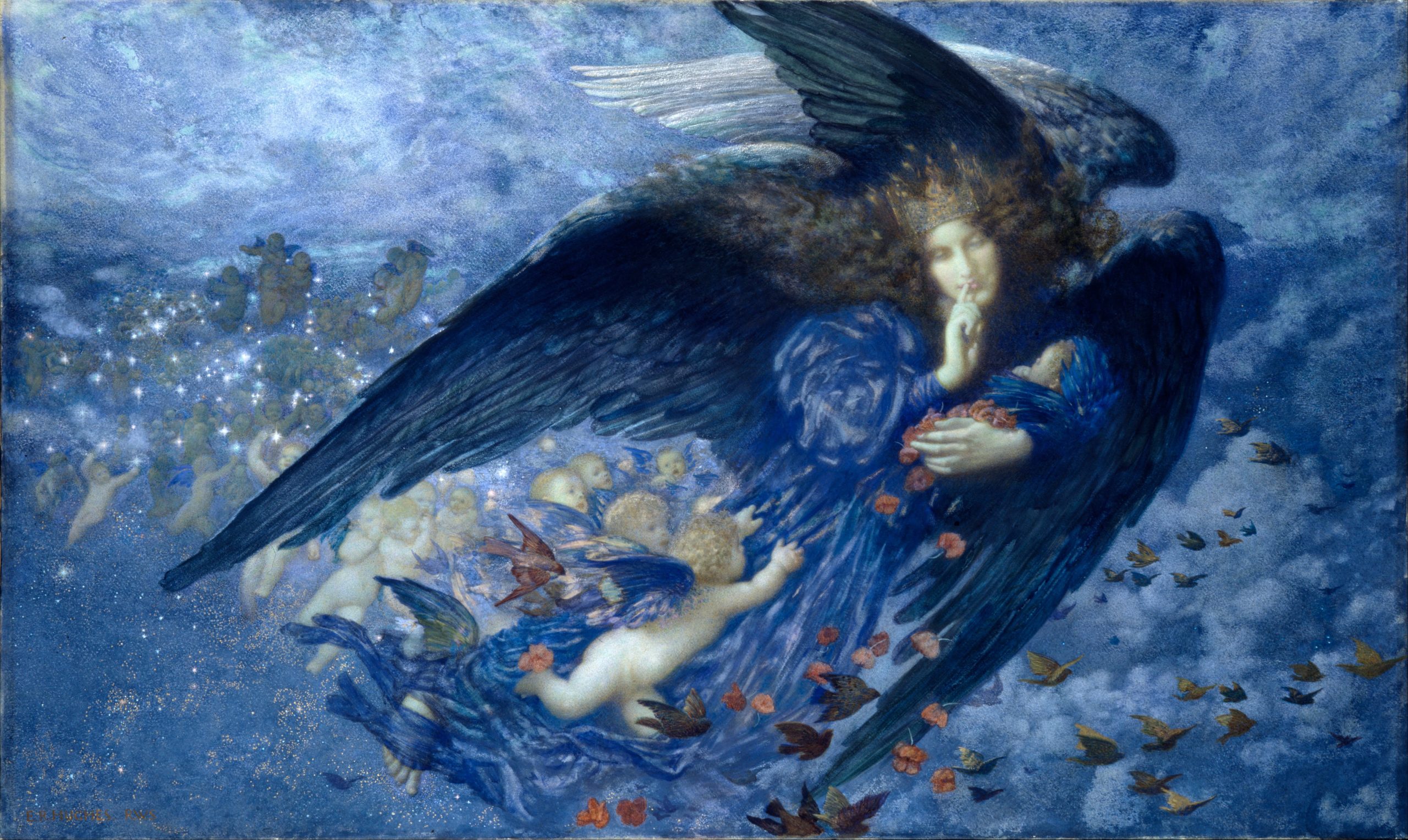

“The Fairies Dancing” by Walter de La Mare
I heard along the early hills,
Ere yet the lark was risen up,
Ere yet the dawn with firelight fills
The night-dew of the bramble-cup,—
I heard the fairies in a ring
Sing as they tripped a lilting round
Soft as the moon on wavering wing.
The starlight shook as if with sound,
As if with echoing, and the stars
Prankt their bright eyes with trembling gleams;
While red with war the gusty Mars
Rained upon earth his ruddy beams.
He shone alone, low down the West,
While I, behind a hawthorn-bush,
Watched on the fairies flaxen-tressed
The fires of the morning flush.
Till, as a mist, their beauty died,
Their singing shrill and fainter grew;
And daylight tremulous and wide
Flooded the moorland through and through;
Till Urdon’s copper weathercock
Was reared in golden flame afar,
And dim from moonlit dreams awoke
The towers and groves of Arroar.
“The Listeners” By Walter De La Mare
‘Is there anybody there?’ said the Traveller,
Knocking on the moonlit door;
And his horse in the silence champed the grasses
Of the forest’s ferny floor:
And a bird flew up out of the turret,
Above the Traveller’s head:
And he smote upon the door again a second time;
‘Is there anybody there?’ he said.
But no one descended to the Traveller;
No head from the leaf-fringed sill
Leaned over and looked into his grey eyes,
Where he stood perplexed and still.
But only a host of phantom listeners
That dwelt in the lone house then
Stood listening in the quiet of the moonlight
To that voice from the world of men:
Stood thronging the faint moonbeams on the dark stair,
That goes down to the empty hall,
Hearkening in an air stirred and shaken
By the lonely Traveller’s call.
And he felt in his heart their strangeness,
Their stillness answering his cry,
While his horse moved, cropping the dark turf,
’Neath the starred and leafy sky;
For he suddenly smote on the door, even
Louder, and lifted his head:—
‘Tell them I came, and no one answered,
That I kept my word,’ he said.
Never the least stir made the listeners,
Though every word he spake
Fell echoing through the shadowiness of the still house
From the one man left awake:
Ay, they heard his foot upon the stirrup,
And the sound of iron on stone,
And how the silence surged softly backward,
When the plunging hoofs were gone.
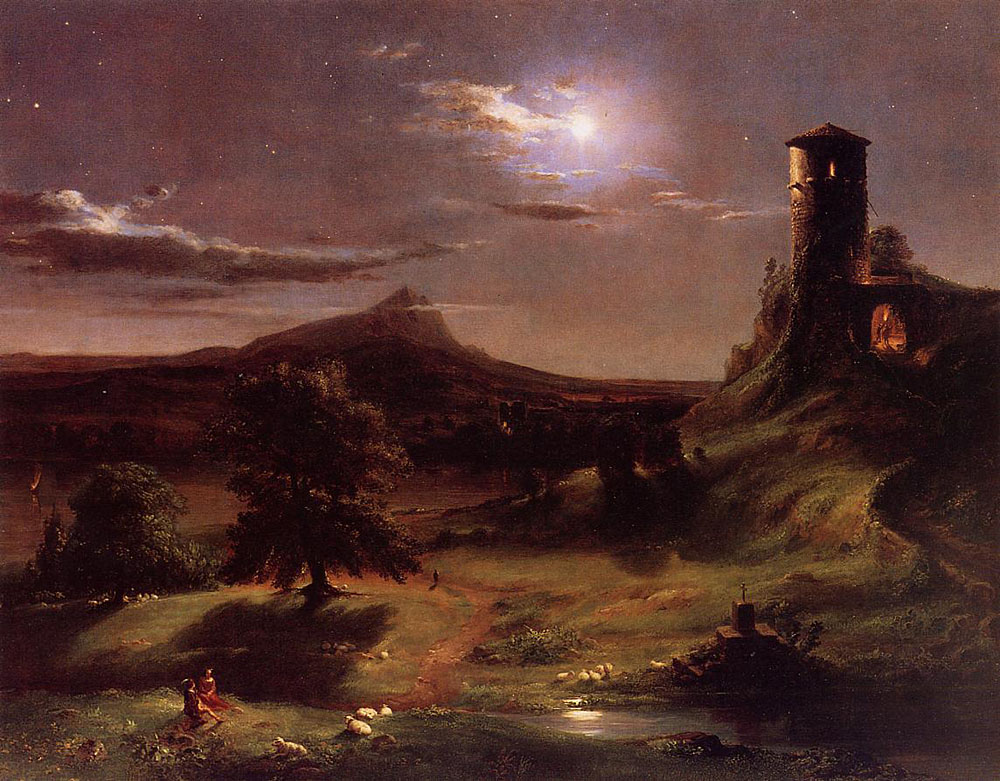
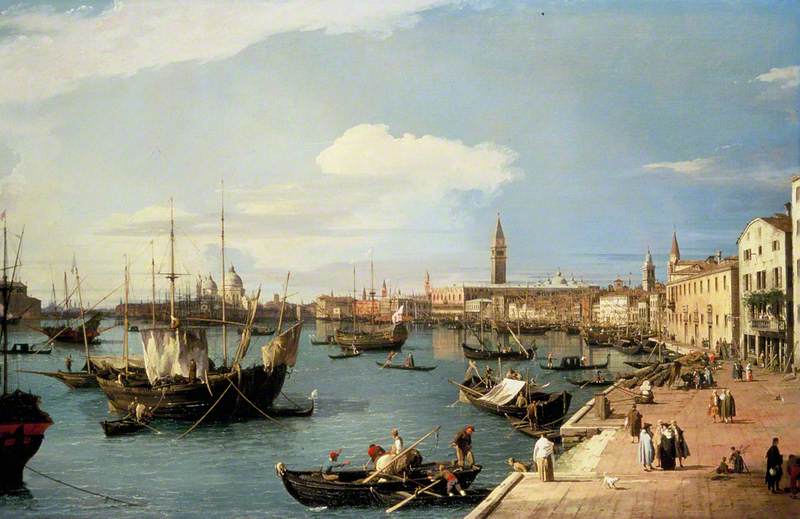
“ I Stood in Venice”by Lord Byron ( George Gordon Byron, 6th Baron Byron) (Excerpt from Childe Roland to the Dark Tower Came, 1852).
I stood in Venice, on the Bridge of Sighs,
A palace and a prison on each hand:
I saw from out the wave her structures rise
As from the stroke of the enchanter’s wand:
A thousand years their cloudy wings expand
Around me, and a dying Glory smiles
O’er the far times, when many a subject land
Looked to the wingéd Lion’s marble piles,
Where Venice sate in state, throned on her hundred isles!
She looks a sea Cybele, fresh from ocean,
Rising with her tiara of proud towers
At airy distance, with majestic motion,
A ruler of the waters and their powers:
And such she was–her daughters had their dowers
From spoils of nations, and the exhaustless East
Poured in her lap all gems in sparkling showers:
In purple was she robed, and of her feast
Monarchs partook, and deemed their dignity increased.
In Venice Tasso’s echoes are no more,
And silent rows the songless gondolier;
Her palaces are crumbling to the shore,
And music meets not always now the ear:
Those days are gone–but Beauty still is here;
States fall, arts fade–but Nature doth not die,
Nor yet forget how Venice once was dear,
The pleasant place of all festivity,
The revel of the earth, the masque of Italy!
Retrieved June 10, 2023 Project Gutenberg ebook https://www.gutenberg.org/files/5131/5131-h/5131-h.htm
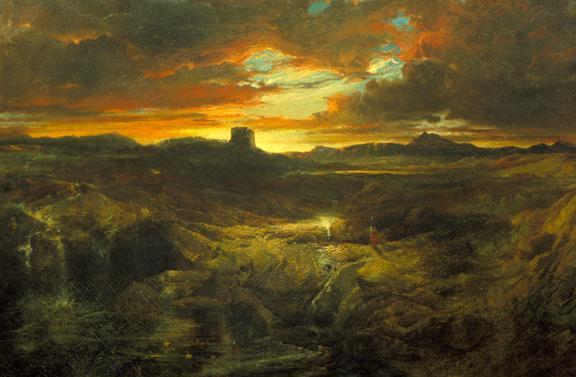
The Poetry Foundation Guide to Reading “Ode to a Grecian Urn” by John Keats
https://www.poetryfoundation.org/articles/145240/john-keats-ode-on-a-grecian-urn
Ode to a Grecian Urn by John Keats (1795-1821)
Thou still unravish’d bride of quietness,
Thou foster-child of silence and slow time,
Sylvan historian, who canst thus express
A flowery tale more sweetly than our rhyme:
What leaf-fring’d legend haunts about thy shape
Of deities or mortals, or of both,
In Tempe or the dales of Arcady?
What men or gods are these? What maidens loth?
What mad pursuit? What struggle to escape?
What pipes and timbrels? What wild ecstasy?
Heard melodies are sweet, but those unheard
Are sweeter; therefore, ye soft pipes, play on;
Not to the sensual ear, but, more endear’d,
Pipe to the spirit ditties of no tone:
Fair youth, beneath the trees, thou canst not leave
Thy song, nor ever can those trees be bare;
Bold Lover, never, never canst thou kiss,
Though winning near the goal yet, do not grieve;
She cannot fade, though thou hast not thy bliss,
For ever wilt thou love, and she be fair!
Ah, happy, happy boughs! that cannot shed
Your leaves, nor ever bid the Spring adieu;
And, happy melodist, unwearied,
For ever piping songs for ever new;
More happy love! more happy, happy love!
For ever warm and still to be enjoy’d,
For ever panting, and for ever young;
All breathing human passion far above,
That leaves a heart high-sorrowful and cloy’d,
A burning forehead, and a parching tongue.
Who are these coming to the sacrifice?
To what green altar, O mysterious priest,
Lead’st thou that heifer lowing at the skies,
And all her silken flanks with garlands drest?
What little town by river or sea shore,
Or mountain-built with peaceful citadel,
Is emptied of this folk, this pious morn?
And, little town, thy streets for evermore
Will silent be; and not a soul to tell
Why thou art desolate, can e’er return.
O Attic shape! Fair attitude! with brede
Of marble men and maidens overwrought,
With forest branches and the trodden weed;
Thou, silent form, dost tease us out of thought
As doth eternity: Cold Pastoral!
When old age shall this generation waste,
Thou shalt remain, in midst of other woe
Than ours, a friend to man, to whom thou say’st,
“Beauty is truth, truth beauty,—that is all
Ye know on earth, and all ye need to know.”
Retrieved May 6, 2023 All Poetry Website. https://www.poetryfoundation.org/poems/44477/ode-on-a-grecian-urn
For more poems by John Keats please open the Project Gutenberg link below.
https://www.gutenberg.org/ebooks/author/935
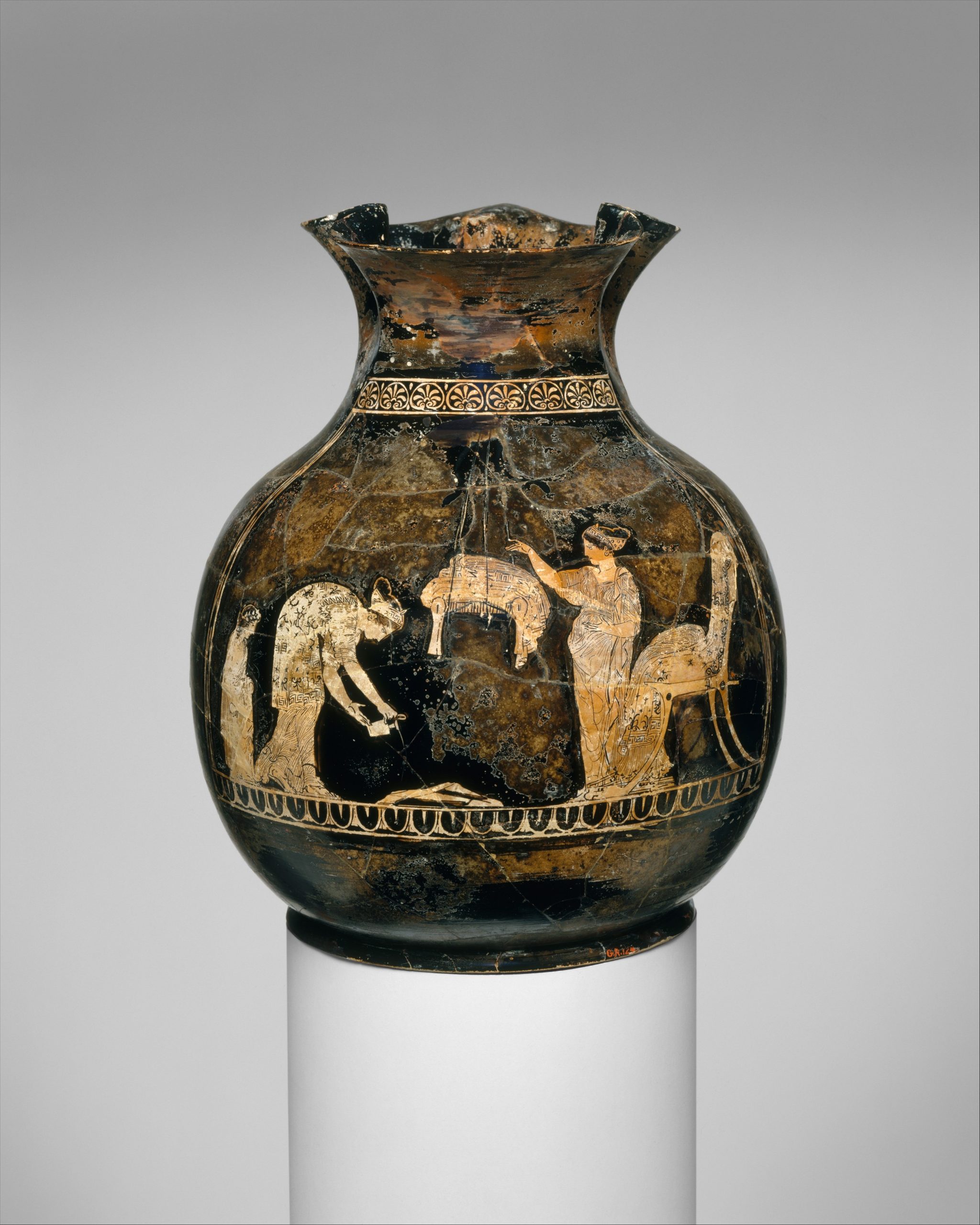
Attice Vase-Red Terra Cotta. 5th century BCE.
Metropolitan Museum of Art Notes:
“The scene depicts two women in festive dress perfuming garments. A stool suspended by chords is piled with folded clothing. On the ground below, there is a pile of wood shavings and twigs from which smoke rises. One woman carefully empties an oinochoe onto the fire. The other woman surveys the “swing” and stands beside a stately chair with a footstool over which more clothes are slung. At the far left is a wreathed boy wearing a himation (cloak). The shape of the vase facilitates the association of the scene with the Anthesteria, a three-day festival held in January/February that celebrated the new wine with the special inclusion of young children, an epiphany of Dionysos, and the ritual marriage of the god with the basilinna, the wife of the chief archon of Athens. While the precise meaning of the scene is not understood, it is evident that the Meidias Painter has melded significant features of the festival into a beautiful tableau.” Retrieved February 25, 2023. https://www.metmuseum.org/art/collection/search/244817
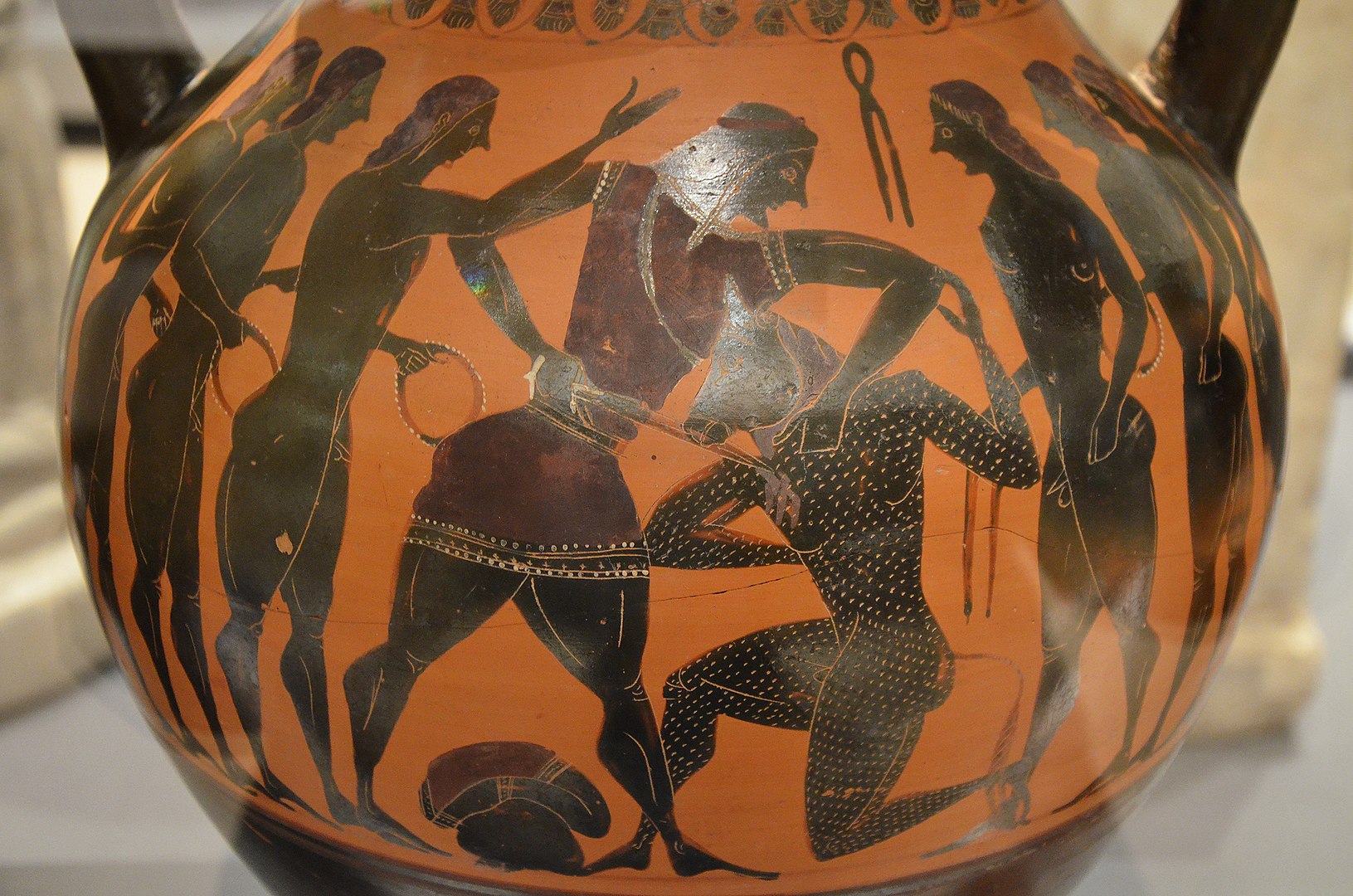
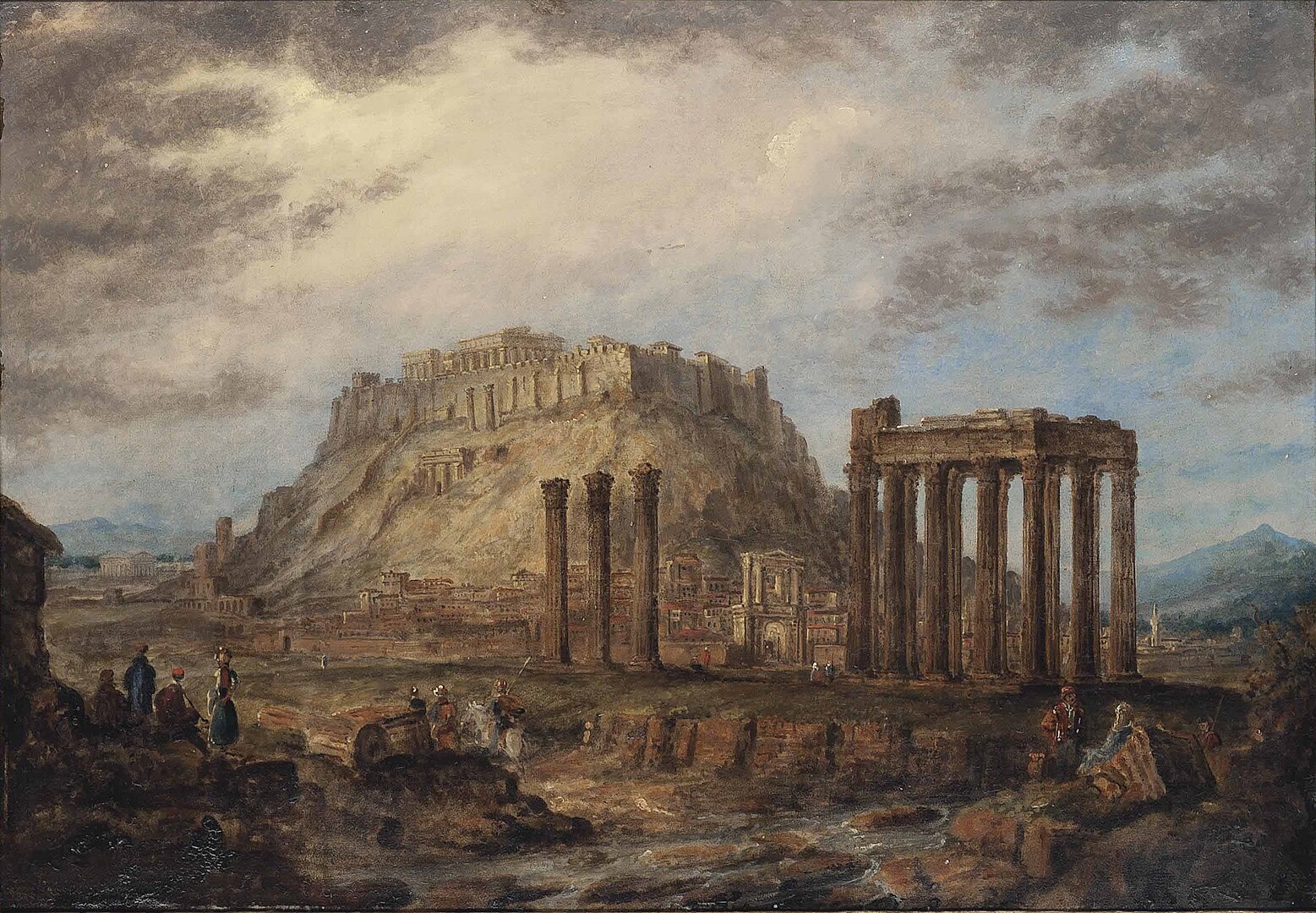
This particular view of Athens was taken from the Ilissus, formerly the principal river of Athens. The location was very appealing to the educated visitor of Athens in the 18th and 19th centuries, because it had inspired Plato’s Dialogue Phaedru. Wikimedia. Public Domain
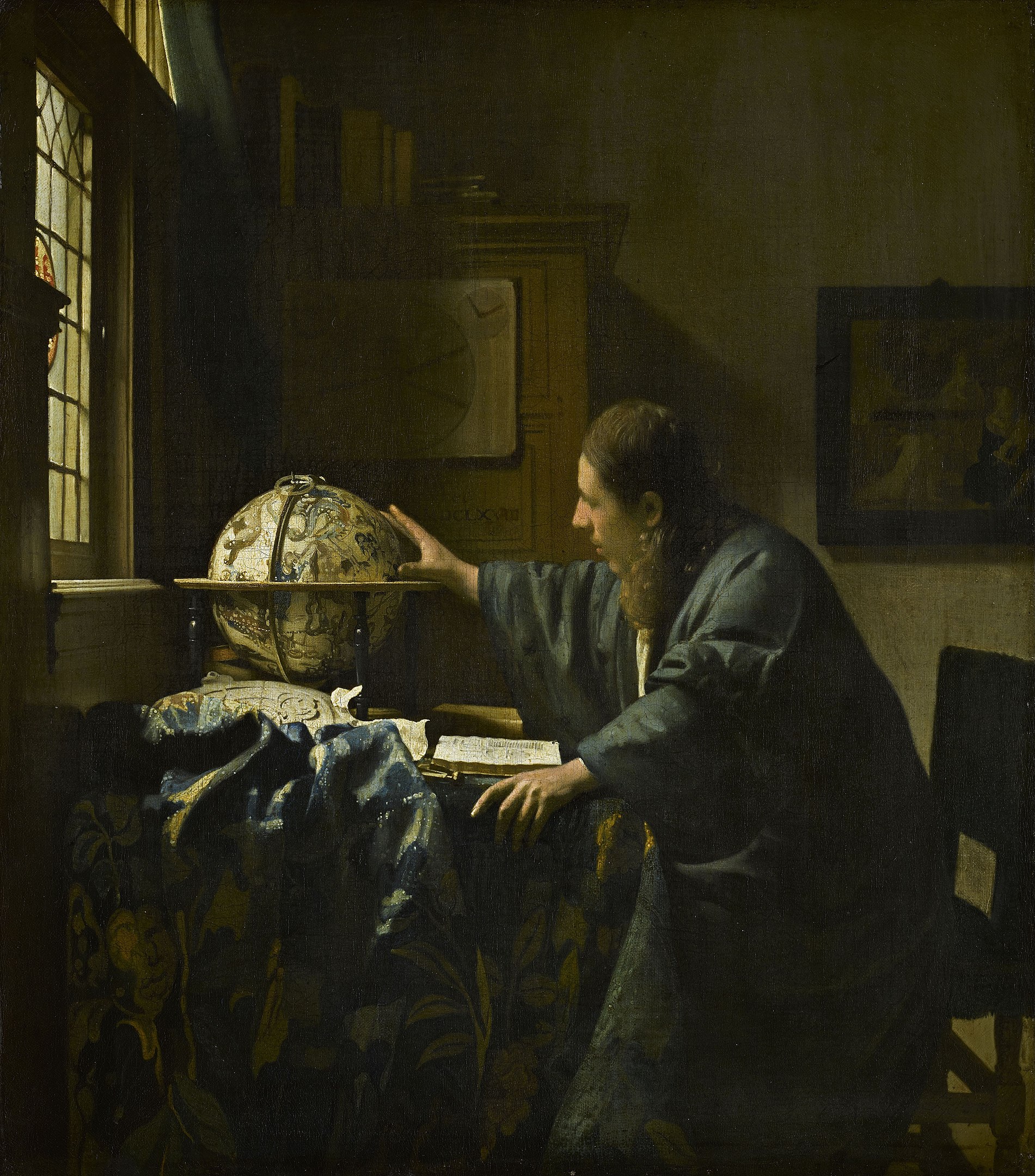
Courtesy: By Johannes Vermeer – https://artsandculture.google.com/asset/wd/bQELiVC_QJaAlQ, Public Domain, https://commons.wikimedia.org/w/index.php?curid=116806430
Astronomy by A.E. Housman (1859-1936)
The Wain upon the northern steep
Descends and lifts away.
Oh, I will sit me down and weep
For bones in Africa.
For pay and medals, name and rank,
Things that he has not found,
He hove the Cross to heaven and sank
The pole-star underground.
And now he does not even see
Signs of the nadir roll
At night over the ground where he
Is buried with the pole.
(Retrieved May 7, 2023 https://www.poetrynook.com/poem/astronomy-1)
Arcturus is his Other Name by Emily Dickinson (1830-1886)
“Arcturus” is his other name —
I’d rather call him “Star.”
It’s very mean of Science
To go and interfere!
I slew a worm the other day —
A “Savant” passing by
Murmured “Resurgam” — “Centipede”!
“Oh Lord — how frail are we”!
I pull a flower from the woods —
A monster with a glass
Computes the stamens in a breath —
And has her in a “class”!
Whereas I took the Butterfly
Aforetime in my hat —
He sits erect in “Cabinets” —
The Clover bells forgot.
What once was “Heaven” Is “Zenith” now —
Where I proposed to go
When Time’s brief masquerade was done
Is mapped and charted too.
What if the poles should frisk about
And stand upon their heads!
I hope I’m ready for “the worst” —
Whatever prank betides!
Perhaps the “Kingdom of Heaven’s” changed —
I hope the “Children” there
Won’t be “new fashioned” when I come —
And laugh at me — and stare —
I hope the Father in the skies
Will lift his little girl —
Old fashioned — naught — everything —
Over the stile of “Pearl.”
(Retrieved May 7, 2023 https://en.wikisource.org/wiki/%22Arcturus%22_is_his_other_name_%E2%80%94
From: The Second Century Anthologies of Verse, Book 2, Oxford, p. 28). William Wordsworth)
“I Wandered Lonely as a Cloud” by William Wordsworth
I wandered lonely as a cloud
That floats on high o’er vales and hills,
When all at once I saw a crowd,
A host, of golden daffodils;
Beside the lake, beneath the trees,
Fluttering and dancing in the breeze.
Continuous as the stars that shine
And twinkle on the milky way,
They stretched in never-ending line
Along the margin of a bay:
Ten thousand saw I at a glance,
Tossing their heads in sprightly dance.
The waves beside them danced; but they
Out-did the sparkling waves in glee:
A poet could not but be gay,
In such a jocund company:
I gazed – and gazed – but little thought
What wealth the show to me had brought:
For oft, when on my couch I lie
In vacant or in pensive mood,
They flash upon that inward eye
Which is the bliss of solitude;
And then my heart with pleasure fills,
And dances with the daffodils.
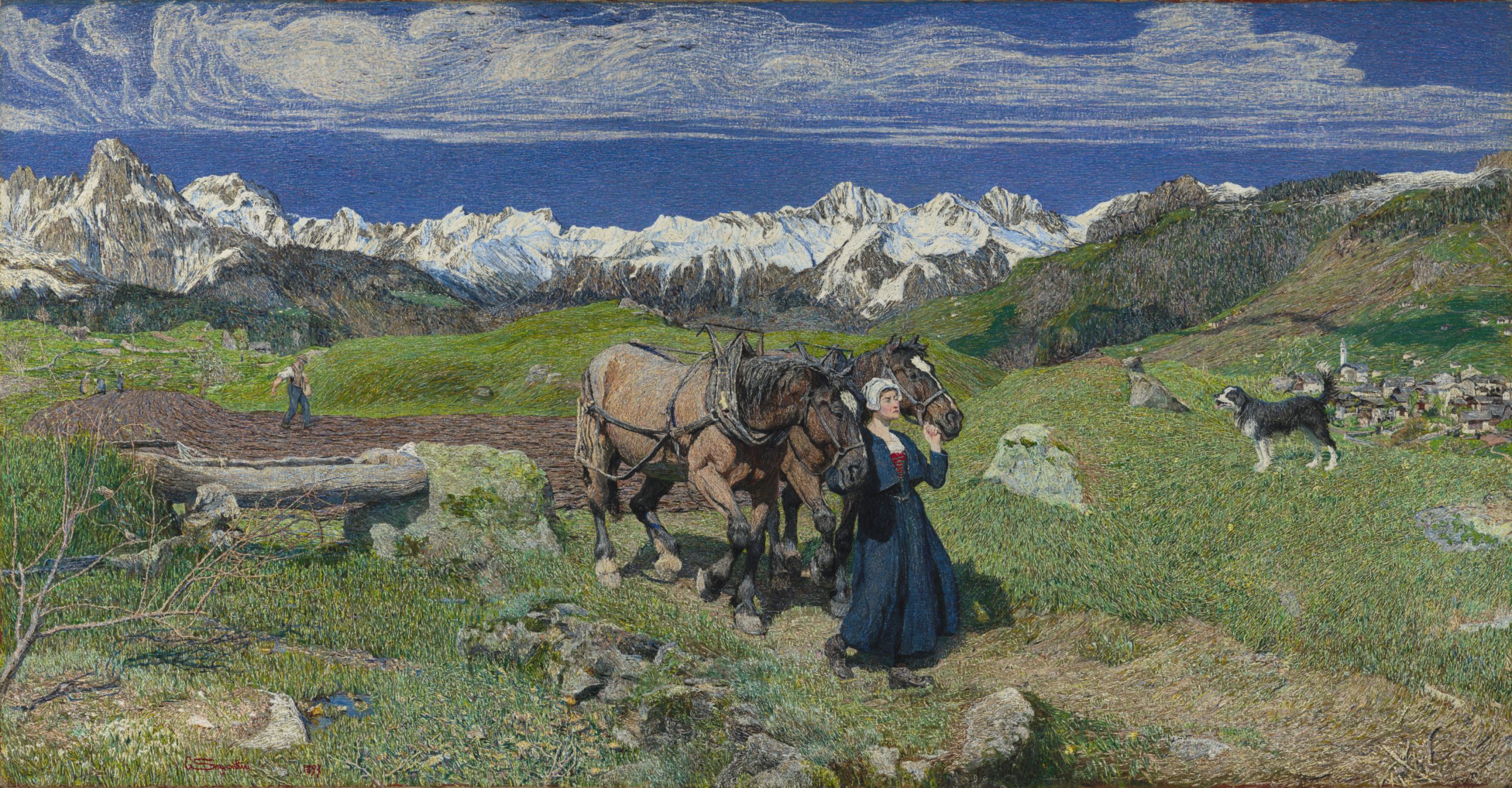
Courtesy: By Giovanni Segantini – Getty Museum, Public Domain, https://commons.wikimedia.org/w/index.php?curid=75916073
The Cloud by Percy Bysshe Shelley

